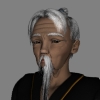Poor G2F has to go barefooted!
 charleshoover885_e228387f57
Posts: 0
charleshoover885_e228387f57
Posts: 0
Come on developers, lets have some shoes for G2F!
Sexy Platforms, Treadz ...
Or somebody come up with a converter that actually works.
Charles
Post edited by charleshoover885_e228387f57 on


Comments
I think there are not so many shoes because it's very hard to make and rig.
There is thread that shows how to convert Genesis shoes to work I cant seem to find it I have not bothered with G2 yet that's one complaint I made to Daz is they keep breaking the shoes every new figure. A side note if one installs Zev's to control for Genesis it also wrecks it's shoes..
In the meantime you can try this:
1. Load you figure (G1 or G2F), than load shoes (I used V4 boots on images).
2. If auto-fit triggers leave figure option "unsupported", type of item "none" and press Accept. If auto-fit doesnt trigger, select shoes in scene tab, than go to parameters tab, under General menu, Misc submenu pick Fit to G1 or G2F, also "unsupported" and "none". You should get something like pic 1.
3. Unfit shoes from figure (select the shoes in scene tab, go to parameters tab, Fit to: none)
4. Use newly created bones to pose the shoes so that they fit your figure. If you have shoes that envelop the foot, you might want to go to surface tab and make shoes slightly transparent by reducing Opacity Strength so you can see your figure foot. Also you might want to reduce the size or scale of the shoes or some area of it like just foot or toes if shoes are too big (V4 shoes are usually bigger than G1 or G2F ones, pic 2). Dont worry if you have slight poke-throughes at this stage, you can use smoothing modifier for that later.
5. When you are done with adjusting the shoes, go to parameters tab of the shoes, general menu, mesh resolution submenu and set subdivision level to 0.
6. Go to scene tab and make your G1 or G2 invisible by clicking on the eye icon in front of them. If you have anything else in the scene, make that invisible as well so that just the shoes are visible.
7. Go to File menu (upper left corner of DS), and pick Export... option.
8. Pick some place for the export (like desktop), pick save type Wavefront Object (*.obj), pick a name like corrective1, or cor1 or whatever you like, click on Save.
9. OBJExportOptions: scale 100%, Ignore Invisible Nodes checked (active), Write groups - use figure names, Write Surfaces - Write Material Library - no maps. Write UV Coordinates, Normals, Object Statements checked (active). Use Bone Velds and Remove Unused Vertices unchecked (not active). Click Accept.
10. Select shoes in your scene tab, go to Edit menu, Figure - Zero - Zero Figure Pose.
11. Go to Edit menu again, Figure - Morph Loader Pro
12. Morph Loader Pro window (pic 3), click on Chose Morph Files... and select object file you exported earlier and Open
13. You should have your object file listed now. Click on little triangle in front of the file to expand options
14. In Reverse Deformations field (or line) click with Right mouse button on letters "no". A small menu will appear, select "Yes". Click Accept.
15. You should get "Created morph successfully" message. Click Ok
16. Fit your shoes to your figure again. In parameters tab, under Morphs, there should be your morph that you created, dial it up to 100% and pose your figure away. :-) (pic 4 G1, pic 5 G2F)
You can add smoothing modifier to the shoes (select the shoes, go to Edit - Figure - Geometry - Apply Smoothing Modifier) and also convert shoes to SubD (select the shoes, go to Edit - Figure - Geometry - Convert to SubD, than increase subdivision level in parameters tab). It helps with bending of toes and foot when you pose the figure (shoes will likely stretch when you bend toes for example)If you are satisfied with result you can save the scene (it will save shoes and morph) or you can save shoes as support asset, figure/prop asset and it will save them with morph and smoothing and SubD.
I normally hide feet/shins when the autofit for shoes doesn't work well and parent them to feet or shins if it's boots. For heels, I manually fit them to the feet and have to readjust when the pose changes.
Lol thats only if you pose the toes. Normally when you apply shoes the feet should be at default state. I found that some toe poses actually help fix some crumpling in areas. But yes.. if you have some toe poses dialled in, expect that to affect the shoes.
Ben (I'm hoping that's your name),
I am absolutely overwhelmed by your detailed response. Occasionally people like you emerge that have a huge affect on others. Your willingness to take the time to put this together in response to someone like me is appreciated beyond my ability to express.
I had not even considered making a morph to deal with the deformation. It works great!
I am now going to take another look at several projects that were shelved because the shoes were so bad.
Thank you again,
Charles
Nope, but its a nickname, so it will do. :)
Thx Charles, its me pleasure. :red: ;-)